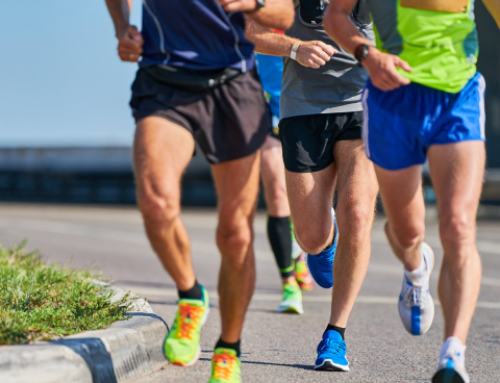How to Safely Decelerate Faster
What is deceleration training?
In virtually every sport, athletes need to be able to control their bodies as well as change direction. Many lower-body injuries happen when the athlete is not conditioned to slow down or stop correctly. Many athletes want to train to increase speed, and although that is obviously necessary, they should also train to decelerate.
RELATED: Deceleration: The Missing Link in Speed Training
Complete the steps on the checklist below. They are listed in order of priority to ensure you will reduce your chance of injury and increase your stability. The progression may take a few months to complete all steps.
Progression for Deceleration Training
1. Establish the Midpoint (athletic stance)
- Stand with your knees bent in a comfortable stance as if shooting a free throw.
- Your nose and belly button should be in line with the middle of your feet.
2. Slow Speed to Full Stop Hold
- Run 50 percent of max speed and stop within 3 steps.
3. Slow Speed to Change in Direction
- Run 50 percent of max speed and change direction on cue from coach.
4. Marching and Skipping Drills
- March or skip for 10-20 yards. This is a technique drill to ensure proper arm-to-foot relationship. When your right arm is in front of your body, your left foot should be up.
5. Jumps in Place
- Small jumps in place. Land softly on the balls of your feet.
6. Box Jumps
- Jump onto a 12-inch box and step down to the ground. Box jumps are intended to create a balanced whole-body movement. Increase height of box at appropriate time.
7. Jump Down (off a box)
- Stand on a box and step down, allowing both feet to hit the ground simultaneously and softly. After you learn how to land properly, run from the landing position.
8. Broad Jumps
- Assume an athletic stance and lower your body to explode as far as possible off both feet. The landing should be soft and quiet.
9. Lateral Jumps
- Stand on one foot and jump laterally, landing on the opposite foot with a soft and quiet step.
Each athlete must first find his or her proper athletic stance, because this allows the coach to prescribe any corrective exercises that might be needed before progressing to step 2.
Step 2 ensures that proper 50-percent running speed technique is correct. If you can’t control your running form at 50 percent, it will be close to impossible eventually to increase your running speed.
You should be able to maintain balance throughout Step 3.
Marching and skipping are teaching steps for coaches to ensure athletes understand the hand-to-foot relationship.
Steps 5-9 teach you to handle your body weight. The number of touches should be limited, because too much too quickly may result in injury. Jumps should be limited to between 60 and 100 touches per session and done after a 48-hour recovery time. The touches for jump training can increase over time.
Learn more deceleration exercises that can help you develop healthier knees.
RECOMMENDED FOR YOU
MOST POPULAR
How to Safely Decelerate Faster
What is deceleration training?
In virtually every sport, athletes need to be able to control their bodies as well as change direction. Many lower-body injuries happen when the athlete is not conditioned to slow down or stop correctly. Many athletes want to train to increase speed, and although that is obviously necessary, they should also train to decelerate.
RELATED: Deceleration: The Missing Link in Speed Training
Complete the steps on the checklist below. They are listed in order of priority to ensure you will reduce your chance of injury and increase your stability. The progression may take a few months to complete all steps.
Progression for Deceleration Training
1. Establish the Midpoint (athletic stance)
- Stand with your knees bent in a comfortable stance as if shooting a free throw.
- Your nose and belly button should be in line with the middle of your feet.
2. Slow Speed to Full Stop Hold
- Run 50 percent of max speed and stop within 3 steps.
3. Slow Speed to Change in Direction
- Run 50 percent of max speed and change direction on cue from coach.
4. Marching and Skipping Drills
- March or skip for 10-20 yards. This is a technique drill to ensure proper arm-to-foot relationship. When your right arm is in front of your body, your left foot should be up.
5. Jumps in Place
- Small jumps in place. Land softly on the balls of your feet.
6. Box Jumps
- Jump onto a 12-inch box and step down to the ground. Box jumps are intended to create a balanced whole-body movement. Increase height of box at appropriate time.
7. Jump Down (off a box)
- Stand on a box and step down, allowing both feet to hit the ground simultaneously and softly. After you learn how to land properly, run from the landing position.
8. Broad Jumps
- Assume an athletic stance and lower your body to explode as far as possible off both feet. The landing should be soft and quiet.
9. Lateral Jumps
- Stand on one foot and jump laterally, landing on the opposite foot with a soft and quiet step.
Each athlete must first find his or her proper athletic stance, because this allows the coach to prescribe any corrective exercises that might be needed before progressing to step 2.
Step 2 ensures that proper 50-percent running speed technique is correct. If you can’t control your running form at 50 percent, it will be close to impossible eventually to increase your running speed.
You should be able to maintain balance throughout Step 3.
Marching and skipping are teaching steps for coaches to ensure athletes understand the hand-to-foot relationship.
Steps 5-9 teach you to handle your body weight. The number of touches should be limited, because too much too quickly may result in injury. Jumps should be limited to between 60 and 100 touches per session and done after a 48-hour recovery time. The touches for jump training can increase over time.
Learn more deceleration exercises that can help you develop healthier knees.











